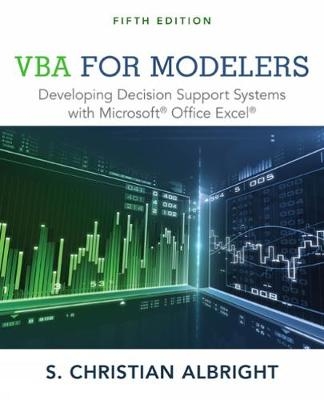
VBA for Modelers
South-Western College Publishing (Verlag)
978-1-285-86961-2 (ISBN)
- Titel ist leider vergriffen;
keine Neuauflage - Artikel merken
Now you can master both basic and advanced skills in Visual Basic for Applications (VBA), the programming language for Microsoft® Office. VBA FOR MODELERS: DEVELOPING DECISION SUPPORT SYSTEMS WITH MICROSOFT OFFICE EXCEL, 5E teaches you how to automate common spreadsheet tasks as well as create the sophisticated management science applications needed in business today.
The first half of the book introduces you to the fundamentals of VBA for Excel®. The second half of the book puts knowledge into action as it illustrates how to automate a number of management science models using VBA. You learn how to create user-friendly interfaces for inputs and results.
This new edition improves code readability, introduces PowerPivot and the new Excel Data Model and shows you how to pass information between modules and user forms while avoiding the use of global variables. VBA FOR MODELERS, 5E offers insights you need to maximize your skills in VBA.
S. Christian Albright received both his B.S. degree in mathematics and his Ph.D. in operations research from Stanford University. He then taught in the Operations and Decision Technologies Department in the Kelley School of Business at Indiana University until his retirement in 2011. He has taught courses in management science, computer simulation and statistics to all levels of business students, including undergraduate, M.B.A. and Ph.D. students. He has published more than 20 articles in leading operations research journals in applied probability. After retiring, he worked for several years for the Palisade Software Company and is the author of several successful textbooks.
1. Introduction to VBA Development in Excel.
Introduction. VBA in Excel 2007 and 2010. Example Applications. Decision Support Systems. Required Background. Visual Basic Versus VBA. Some Basic Terminology. Summary.
2. The Excel Object Model.
Introduction. Objects, Properties, Methods, and Events. Collections as Objects. The Hierarchy of Objects. Object Models in General. Summary.
3. The Visual Basic Editor.
Introduction. Important Features of the VBE. The Object Browser. The Immediate and Watch Windows. A First Program. Intellisense. Color Coding and Case. Finding Subs in the VBE. Summary.
4. Recording Macros.
Introduction. How to Record a Macro. Changes from Excel 2007 to Excel 2010. Recorded Macro Examples. Summary.
5. Getting Started with VBA.
Introduction. Subroutines. Declaring Variables and Constants. Built-In Constants. Input Boxes and Message Boxes. Message Boxes with Yes and No Buttons. Using Excel Functions in VBA. Comments. Indenting. Strings. Specifying Objects, Properties, and Methods. With Construction. Other Useful VBA Tips. Good Programming Practices. Debugging. Summary.
6. Working with Ranges.
Introduction. Exercise. Important Properties and Methods of Ranges. Referencing Ranges with VBA. Examples of Ranges with VBA. Range Names and Their Scope. Summary.
7. Control Logic and Loops.
Introduction. Exercise. If Constructions. Case Constructions. For Loops. For Each Loops. Do Loops. Summary.
8. Working with Other Excel Objects.
Introduction. Exercise. Collections and Members of Collections. Examples of Workbooks in VBA. Examples of Worksheets in VBA. Examples of Charts in VBA. Summary.
9. Arrays.
Introduction. Exercise. The Need for Arrays. Rules for Working with Arrays. Examples of Arrays in VBA. Array Functions. Summary.
10. More on Variables and Subroutines.
Introduction. Exercise. Scope of Variables and Subroutines. Modularizing Programs. Passing Arguments. Function Subroutines. The Workbook Open Event Handler. Summary.
11. User Forms
Introduction. Exercise. Designing User Forms. Setting Properties of Controls. Creating a User Form Template. Writing Event Handlers. Displaying a User Form. Looping Through the Controls on a User Form. Working with List Boxes. Modal and Modeless. Working with Excel Controls. Summary.
12. Error Handling.
Introduction. Error Handling with On Error Statement. Handling Inappropriate User Inputs. Summary.
13. Working with Files and Folders.
Introduction. Exercise. Dialog Boxes for File Operations. The File System Object. A File Renaming Example. Working with Text Files. Summary.
14. Importing Data into Excel from a Database.
Introduction. Exercise. A Brief Introduction to Relational Databases. A Brief Introduction to SQL. ActiveX Data Objects (ADO). Discussion of the Sales Orders Exercise. Summary.
15. Working with Pivot Tables and Tables.
Introduction. Working with Pivot Tables Manually. Working with Pivot Tables Using VBA. An Example. Working with Excel Tables Manually. Working with Excel Tables with VBA. Summary.
16. Working with Ribbons, Menus, and Toolbars.
Introduction. Customizing Ribbons in Excel 2010. Using RibbonX and XML to Customize Ribbons. Using RibbonX to Customize the QAT. CommandBar and Related Office Objects. A Grading Program Example. Summary.
17. Automating Solver and Other Applications.
Introduction. Exercise. Automating Solver with VBA. Possible Solver Problems. Programming with Risk Solver Platform. Automating Palisade Add-Ins with VBA. Automating Other Office Applications with VBA. Summary.
18. User-Defined Types, Enumerations, Collections, and Classes.
User-Defined Types. Enumerations. Collections. Classes. Summary.
Part II: VBA MANAGEMENT SCIENCE APPLICATIONS.
19. Basic Ideas for Application Development with VBA.
Introduction. Guidelines for Application Development. A Car Loan Application. Summary.
20. A Blending Application.
Introduction. Functionality of the Application. Running the Application. Setting Up the Excel Sheets. Getting Started with the VBA. The
| Verlagsort | Florence |
|---|---|
| Sprache | englisch |
| Maße | 187 x 30 mm |
| Gewicht | 1088 g |
| Themenwelt | Informatik ► Office Programme ► Office |
| Mathematik / Informatik ► Informatik ► Software Entwicklung | |
| Wirtschaft ► Volkswirtschaftslehre ► Ökonometrie | |
| ISBN-10 | 1-285-86961-3 / 1285869613 |
| ISBN-13 | 978-1-285-86961-2 / 9781285869612 |
| Zustand | Neuware |
| Informationen gemäß Produktsicherheitsverordnung (GPSR) | |
| Haben Sie eine Frage zum Produkt? |
aus dem Bereich


